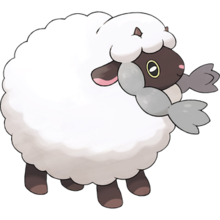
Pokémon is a Japanese media franchise consisting of video games, animated series and films, a trading card game, and other related media. The franchise takes place in a shared universe in which humans co-exist with creatures known as Pokémon, a large variety of species endowed with special powers. The franchise's target audience is children aged 5 to 12, but it is known to attract people of all ages.

Pikachu is a fictional species of the Pokémon media franchise. Designed by Atsuko Nishida and Ken Sugimori, Pikachu first appeared in the 1996 Japanese video games Pokémon Red and Pokémon Green created by Game Freak and Nintendo, which were released outside of Japan in 1998 as Pokémon Red and Pokémon Blue. Pikachu is a yellow, mouse-like creature with electrical abilities. It is a major character in the Pokémon franchise, serving as its mascot.

Pokémon is a series of video games developed by Game Freak and published by Nintendo and The Pokémon Company under the Pokémon media franchise. It was created by Satoshi Tajiri with assistance from Ken Sugimori, the first games, Pocket Monsters Red and Green, were released in 1996 in Japan for the Game Boy, later released outside of Japan as Pokémon Red Version and Blue Version. The main series of role-playing video games (RPGs), referred as the "core series" by their developers, has continued on each generation of Nintendo's handhelds. The most recently released core series games, Pokémon Scarlet and Violet, were released on November 18, 2022, for the Nintendo Switch.

Charizard, known in Japan as Lizardon, is a Pokémon in Nintendo and Game Freak's Pokémon franchise. Created by Atsuko Nishida, Charizard first appeared in the video games Pokémon Red and Blue and subsequent sequels. They have later appeared in various merchandise, spinoff titles and animated and printed adaptations of the franchise. Shin-ichiro Miki voices Charizard in both the Japanese and English-language versions of the anime. An orange, dragon-like Pokémon, Charizard is the evolved form of Charmeleon and the final evolution of Charmander. It also has two "Mega Evolved" forms, Mega Charizard X and Y, that were likely both designed by Tomohiro Kitakaze, the designer of Mega Charizard X. It also has a Gigantamax form in Pokémon Sword and Shield, which changes its appearance and size.

Bulbasaur is a fictional Pokémon species in Nintendo and Game Freak's Pokémon franchise. Designed by Atsuko Nishida, Bulbasaur is a Grass and Poison-type, first appearing in Pocket Monsters: Red and Green as a starter Pokémon. Since then, it has reappeared in sequels, spin-off games, related merchandise, and animated and printed adaptations of the franchise. It is a central character in the Pokémon anime, being one of Ash Ketchum's main Pokémon for the first season, with a different one later being obtained by supporting character May. It is featured in various manga and is owned by protagonist Red in Pokémon Adventures.
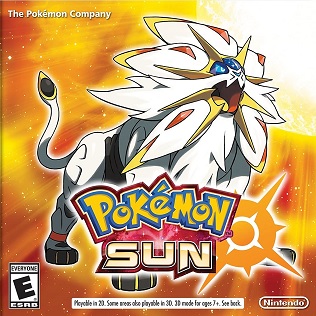
Pokémon Sun and Pokémon Moon are 2016 role-playing video games developed by Game Freak and published by The Pokémon Company and Nintendo for the Nintendo 3DS. They are the first installments in the seventh generation of the Pokémon video game series. First announced in February 2016, Sun and Moon were released worldwide on 18 November 2016, commemorating the franchise's 20th anniversary. A pair of enhanced versions, Pokémon Ultra Sun and Pokémon Ultra Moon, were released for the same consoles on 17 November 2017.
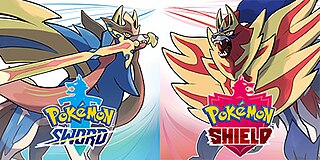
Pokémon Sword and Pokémon Shield are 2019 role-playing video games developed by Game Freak and published by The Pokémon Company and Nintendo for the Nintendo Switch console. They are the first instalments in the eighth generation of the Pokémon video game series. First teased at E3 2017 and announced in February 2019, the games were released in November 2019. The games were accompanied by a downloadable content (DLC) expansion pass consisting of Part 1—The Isle of Armor and Part 2—The Crown Tundra ; its launch marked the first ever DLC released as part of the Pokémon video game series.

Pokémon: Twilight Wings is a Japanese original net animation anime series produced by Studio Colorido and released on YouTube by The Pokémon Company. It is a series inspired by the Pokémon Sword and Shield titles of the Pokémon video games, but it is not a part of the television series. A total of eight episodes, were announced for the series on December 12, 2019. The first episode was released on January 15, 2020, and further episodes were planned to be released on a monthly basis, however the fifth episode was delayed from May to June due to the COVID-19 pandemic. This series, for the first seven episodes, also serves as a prequel to the Sword and Shield titles.

Pokémon Sword and Shield: The Isle of Armor is the first of two downloadable content expansion packs in the Pokémon Sword and Shield Expansion Pass for the 2019 role-playing video games Pokémon Sword and Shield on Nintendo Switch. It was developed by Game Freak and published by The Pokémon Company and Nintendo for the Nintendo Switch. It was released worldwide on June 17, 2020. It precedes The Crown Tundra. The Pokémon Sword and Shield Expansion Pass physical bundle pack was released on November 6, 2020.
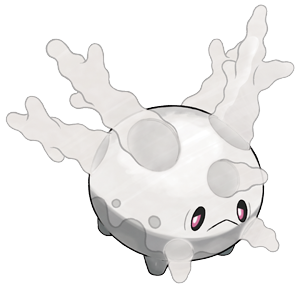
Galarian Corsola, known in Japan as GalarianSunnygo (サニーゴ) is a Pokémon species in Nintendo and Game Freak's Pokémon media franchise. First introduced in the video games Pokémon Sword and Shield, it is based off of coral, particularly bleached coral. It is a regional variant- a version of a Pokémon that is biologically unique to an in-game region- of the Pokémon Corsola, which was introduced in Pokémon Gold and Silver. In the games' lore, this variation of Corsola went extinct in the Galar region, the main setting of Sword and Shield, a long time before the events of the games.
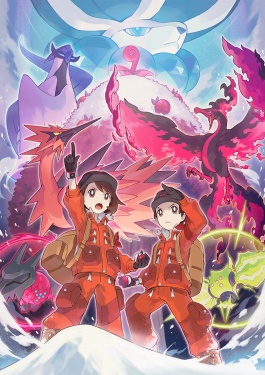
Pokémon Sword and Shield: The Crown Tundra is the second of two downloadable content expansion packs in the Pokémon Sword and Shield Expansion Pass for the 2019 role-playing video games Pokémon Sword and Shield on Nintendo Switch. It is developed by Game Freak and published by The Pokémon Company and Nintendo for the Nintendo Switch. It was released on October 22, 2020. It follows The Isle of Armor, which was released on June 17, 2020. The Pokémon Sword and Shield Expansion Pass physical bundle pack was released on November 6, 2020.

Shigeru Ohmori is a Japanese video game director, designer, and developer best known for his work in the Pokémon franchise. He has worked in Game Freak since 2001, and has been the primary director of Pokémon video game titles since Pokémon Omega Ruby and Alpha Sapphire in 2014.

The Poké Ball Plus is a video game controller based on a Poké Ball, a device used in the Pokémon fictional universe to catch Pokémon. It was developed and manufactured by Nintendo and released on November 16, 2018. The controller is compatible with the video games Pokémon GO, Pokémon: Let's Go, Pikachu! and Let's Go, Eevee!, and Pokémon Sword and Shield. It substitutes the ball's button for an analog stick that can be pressed inwards to function as the A button, while a hidden button atop the ball acts as the B button. It also contains motion sensors to simulate throwing the ball, HD Rumble feedback, and LEDs and speakers to mimic a Pokémon being caught. It has further functionality as a Pokémon GO Plus, allowing players to catch Pokémon without using their phone directly. The legendary Pokémon Mew is included digitally with every Poké Ball Plus. The controller received positive reviews from critics, who highly recommended it to fans of the franchise due to its high quality, despite its lack of functionality elsewhere.

Sobble, known in Japan as Messon (メッソン), is a Pokémon species in Nintendo and Game Freak's Pokémon franchise. It was first introduced in Pokémon Sword and Shield and was one of three Pokémon available to the player at the beginning of the game, along with Grookey and Scorbunny. It is a Water-type Pokémon and evolves into Drizzile, then Inteleon, both of which are also Water-type. Critical response was mixed. While some reviewers praised Sobble's design and personality, some were confused as to why Sobble cried, calling it "annoying".

Arctovish, Arctozolt, Dracovish, and Dracozolt—known as Uochilldon (ウオチルドン) Patchilldon (パッチルドン) Uonoragon (ウオノラゴン) and Patchiragon (パッチラゴン) in Japan, respectively—are a quartet of Pokémon species who first appeared in Pokémon Sword and Shield. They are considered some of the series' "Fossil Pokémon", species that are brought back to life through fossils. Unlike other fossil Pokémon, the quartet are composed of pairs of parts haphazardly put together, appearing to be inspired by the Crystal Palace Dinosaurs as well as similarly inaccurate reconstructions of dinosaurs.

Nessa, known in Japan as Rurina, is a fictional character in Nintendo and Game Freak's Pokémon franchise. Designed by illustrator Take Oekaki and introduced in the 2019 video games Pokémon Sword and Shield, she is a model that also acts as a Gym Leader, specializing in Water-type Pokémon. Since her initial appearance she has appeared in additional media related to the franchise, including Pokémon Masters EX and anime Pokémon: Twilight Wings. In Japanese she is voiced by Sora Amamiya, while in English she has been voiced by Anairis Quinones and Tiana Camacho.
Hop is a fictional character in Nintendo and Game Freak's Pokémon franchise. Introduced in the 2019 video games Pokémon Sword and Shield, he is the one of multiple rivals to the protagonist and the brother of the Pokémon League Champion, Leon, aspiring to become the Champion himself. He has a Wooloo as his first Pokémon, and later receives either Grookey, Scorbunny, or Sobble, picking whichever Pokémon is weak to whichever of the three the protagonist chose. He has received mixed reception, noted in both positive and negative commentary as a bad trainer. He has also been criticized for being annoying due to how often he appears in cutscenes and tutorials. This criticism caused people to defend him, with one sentiment being that having a nice rival to complement more competitive or mean rivals is a good quality of the games.
